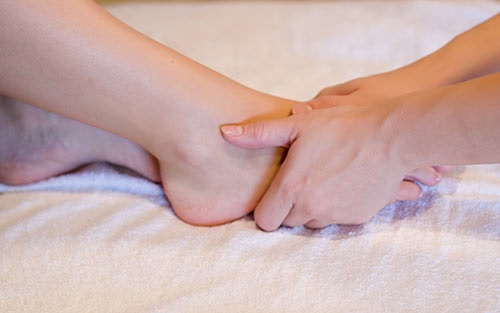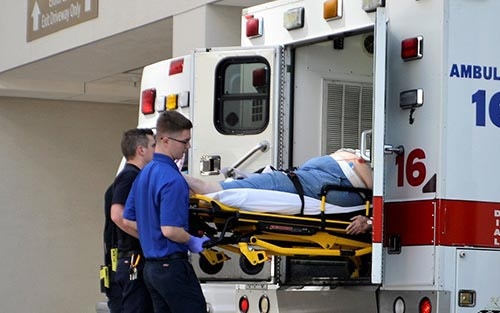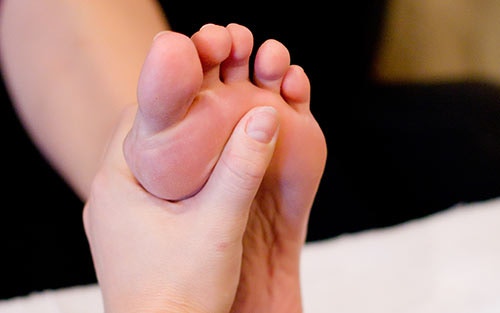Is Lou Gehrig’s disease (ALS) causing the loss of your mobility and quality of life? While a cure has not been found for ALS, there are treatments to slow it down and ease the pain associated with it.

yourfootpalace.com gathered the following information to give you a breakdown of what Lou Gehrig’s disease is, its symptoms, and effective therapies for those afflicted by it.
What Is Lou Gehrig’s Disease?
Lou Gehrig’s disease, known medically as amyotrophic lateral sclerosis or ALS, is the more commonly occurring of four types of a progressive nervous system disorder called motor neuron disease (MND). The four types of MND’s include:
• Amyotrophic Lateral Sclerosis (ALS)
• Progressive bulbar palsy (PBP)
• Progressive muscular atrophy (PMA)
• Primary lateral sclerosis (PLS)
ALS and the other types of MND’s affect nerve cells in the brain and spinal cord, causing loss of muscle control. According to the ALS Association, ALS occurs in people between the ages of 40 and 70, and that a minimum of 16,000 Americans have the disease at any given time.
The disease garnered its popular name after the six-time World Series champion and Hall of Fame baseball player – Lou Gehrig was diagnosed with it in 1939.
ALS returned to the public’s attention during the summer of 2014 when the ALS Ice Bucket Challenge went viral on virtually all social media platforms.
What Are The Symptoms of ALS?
The signs and symptoms signaling the onset of ALS can be overlooked easily due to their subtlety in the early stages of the disease. Gradually, these symptoms will develop into more pronounced weakness or atrophy, causing a physician to suspect ALS.
Limb Onset ALS refers to symptoms that originate in the arms or legs such as:
• Muscle twitches (fasciculations) in the arm, leg, shoulder, or tongue
• Difficulty writing, turning a doorknob, and other simple tasks
• Difficulty walking or keeping balance
• Frequent tripping and/or falling
• Hand weakness
• Weakness in a leg, foot or ankle
• Muscle cramps
• Tightening and/or stiffening of muscles (spasticity)
• Muscle weakness affecting an arm, a leg, neck or diaphragm

Bulbar Onset ALS refers to symptoms affecting speech and swallowing, such as:
• Slurred speech (dysarthria)
• Difficulty chewing and/or swallowing (dysphagia)
• Difficulty breathing (dyspnea)

Along with the physical symptoms listed above, inappropriate and/or spontaneous yawning, laughing, or crying and behavioral changes may accompany any stage of the disease.
Note: Regardless of where the symptoms of ALS begin, muscle weakness and atrophy will affect other parts of the body as the disease progresses.
ALS Treatment And Therapy
As of the writing of this article, there are no measures to prevent or cure Lou Gehrig’s disease. However, some medical treatments and therapies can help control the disease’s symptoms and avoid unnecessary complications.
Medication – Currently, there are two drugs approved by the U.S. Food and Drug Administration (FDA) that may be prescribed to treat and slow the progression of ALS.
• Riluzole (Rilutek) was the first treatment for ALS approved by the FDA and is believed to decrease glutamate levels, reducing motor neuron damage. Glutamate conveys signals between nerve cells and motor neurons. Rilutek has shown to be most effective in treating the bulbar form of the disease but has not demonstrated the ability to reverse damages done to motor neurons.
• Edaravone (Radicava) is a neuroprotective agent that has shown the capability to slow the decline of physical functioning in ALS patients.
Other medications may be prescribed to help suppress or manage the following:
• Muscle cramps
• Stiffness
• Excess saliva
• Phlegm
• Pain
• Depression
• Constipation

Consult your physician and/or pharmacist before administering medication (prescription or over the counter) to anyone undergoing treatment by medication. The proper use and dosages of a person’s prescriptions will help prevent the risk of drug interactions.
Nutrition – ALS victims have a tendency to become weaker when they lose weight. A nutritionist can educate caregivers and family members on planning and preparing smaller meals throughout the day, delivering enough fluid, fiber, and calories while steering away from foods that may present a choking hazard.
As the disease progresses and the ability to eat is severely impaired or lost, doctors may resort to the use of a feeding tube. This measure reduces the risk of choking and pneumonia caused by inadvertently inhaling liquids into the lungs.
Physical Therapy – Low-impact aerobic exercises like walking, swimming, and stationary bicycling all work to strengthen non-impacted muscles, improve cardiovascular health, and fight fatigue and depression. Range of motion exercises combined with stretching routines help prevent painful spasticity and shortening of impacted muscles.
Occupational therapists may recommend devices intended to help patients remain mobile, conserve energy, and minimize the risk of falling, such as braces, walkers, motorized wheelchairs, and ramps.
Massage Therapy – massage therapy can help the physical, emotional, and psychological well-being of those with ALS by:
• Increasing mobility
• Reducing muscle pain and cramping
• Preventing stiff joints
• Increasing circulation
• Reducing anxiety
Those with debilitating diseases like ALS do not receive enough touch as family and friends may see them as fragile and fear hurting them. A trained massage therapist can offer caring and needed touch.

ALS patients may lose muscle strength and mobility, but they remain fully conscious and retain their sense of touch.
Speech Therapy – A speech therapist can help an ALS patient quickly adapt to the progression of the disease and maintain their ability to communicate. Some of the methods may include:
• Simple responses with their eyes or other nonverbal means
• Computer-based speech synthesizers with eye-tracking technology
• Voice banking to store their own voice for future use with speech synthesizers
Beginning speech therapy early can result in an extended capacity to communicate fully with rich content.
Breathing Assistance – One of the eventualities of ALS progression is the weakening of the muscles responsible for breathing. As one begins to experience shortness of breath and difficulty breathing, the following treatments may be recommended progressively:
• Noninvasive Ventilation (NIV) is breathing support delivered through a mask.
• Mechanical Ventilation (respirator) is breathing support in which a machine inflates and deflates the lungs. For this breathing assistance, a breathing tube is inserted through the mouth or surgically inserted through a hole in the front of the neck.
Breathing assistance may ease difficulties with breathing and prolong one’s life, but it does not impact the progression of ALS.
The Impact of ALS
As a loved one becomes further physically restricted, family members can become overwhelmed. Clear and direct communication becomes hindered as the disease affects breathing, muscles used for speech, and arm movement. The following are ways for family members to better understand and cope with the progression of ALS:
• An ALS victim may require more time to respond to you, be patient. Remember that your loved one can still think clearly.
• Sense of touch remains throughout the progression of the disease. It is normal for people to refrain from physical contact for fear of hurting the person. A lack of physical contact can deepen one’s depression and feelings of loneliness.
• Counseling and support from family and friends can ease the stress and challenges caused by the progressive nature of the disease.
• Call the ALS Association hotline for information about support groups, referral services, and your local ALS Association chapter at (800) 782-4747

Those afflicted with ALS should be treated with dignity and respect as they consciously experience the gradual loss of their mobility and freedom.
One example of how quality treatment and care for ALS patients can have an enduring impact is the life of Stephen Hawking. The English theoretical physicist, cosmologist, and author who was serving as director of research at the Centre for Theoretical Cosmology at the University of Cambridge in March 2018, when he passed away after having lived with the disease for more than 50 years.

Amyotrophic Lateral Sclerosis Is Lou Gehrig’s Disease
In this article, you discovered what ALS is, its associated symptoms, and the therapies used to slow its progression while providing comfort for this afflicted by it.
By seeking treatment, therapy, and education from the initial stages of ALS, you can significantly extend your life while increasing the quality of the time you have.
Your avoiding treatment and therapy for ALS symptoms can result in a drastic reduction in your quality of life. This decision may exponentially increase the difficulty for your loved ones to cope with the progression of the disease.
Sources:
mayoclinic.org/diseases-conditions/amyotrophic-lateral-sclerosis/symptoms-causes/syc-20354022
amtamassage.org/articles/1/news/detail/3001/the-power-of-touchR-for-als
alsa.org/about-als/what-is-als.html
mndnsw.asn.au/index.php?option=com_content&view=article&id=44:mndforms&catid=34:what-is-mnd
cdc.gov/als/WhatisAmyotrophiclateralsclerosis.html
alsworldwide.org/care-and-support/article/massage-therapy-for-caregivers
pacificcollege.edu/news/blog/2014/12/06/massage-lou-gehrigs-disease
(706) 521-5290
(678) 963-5958